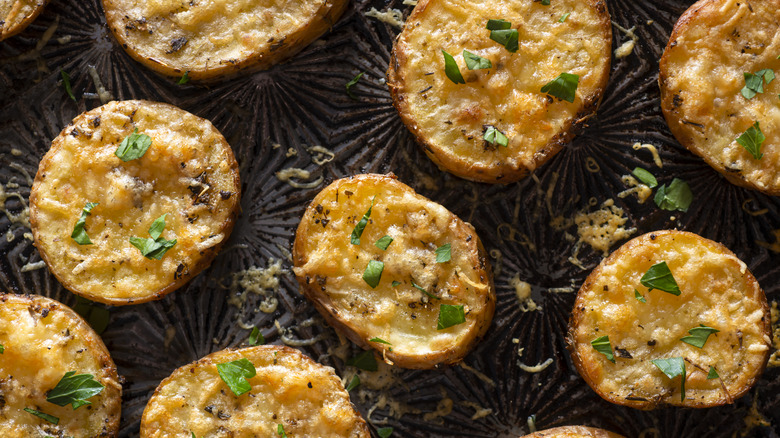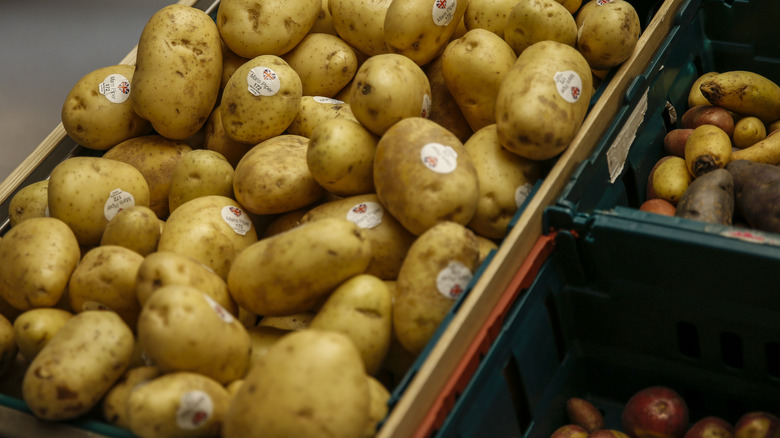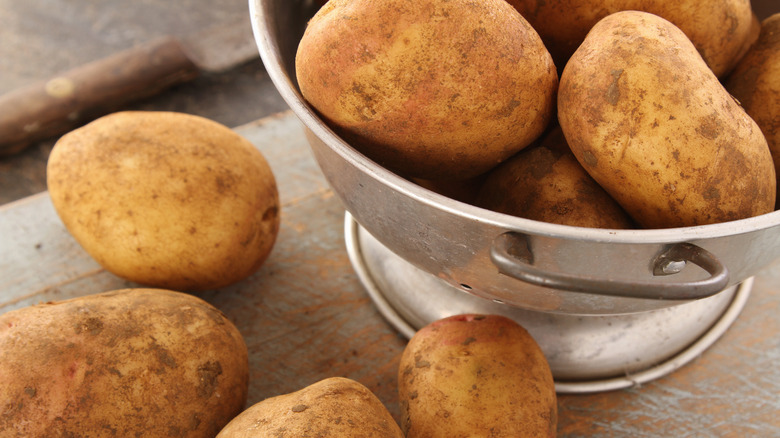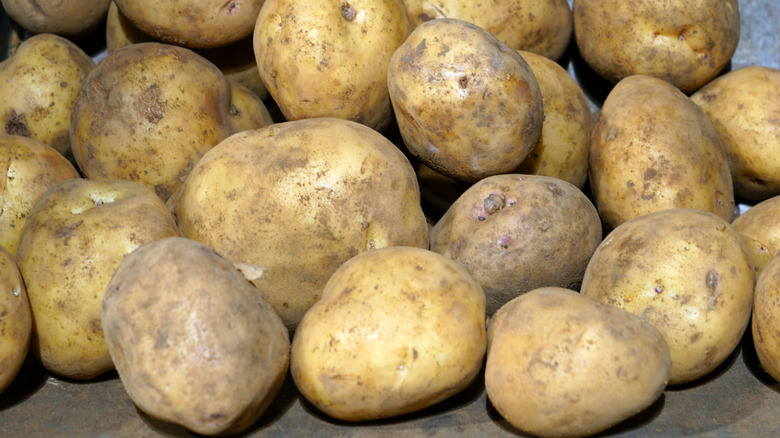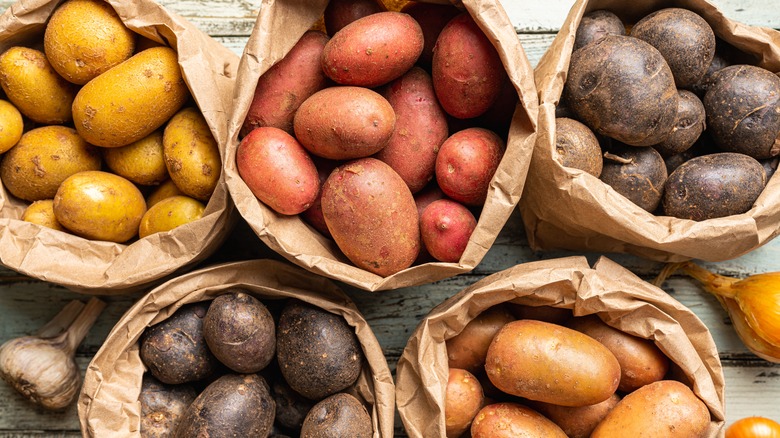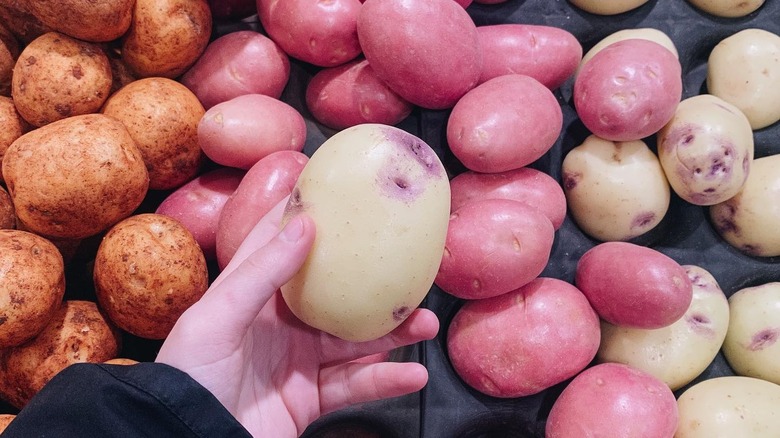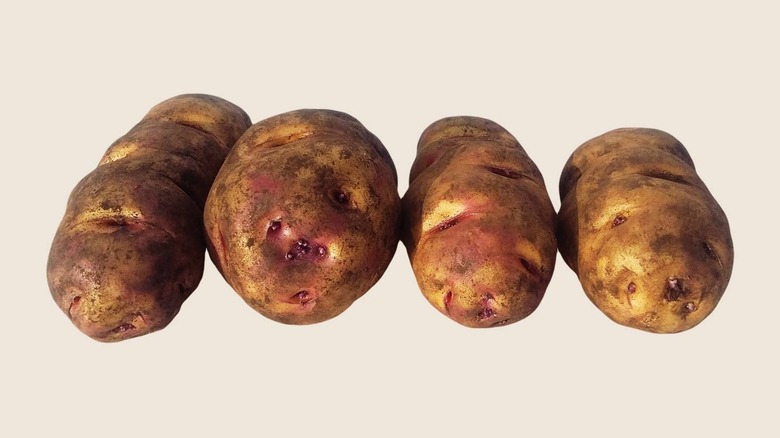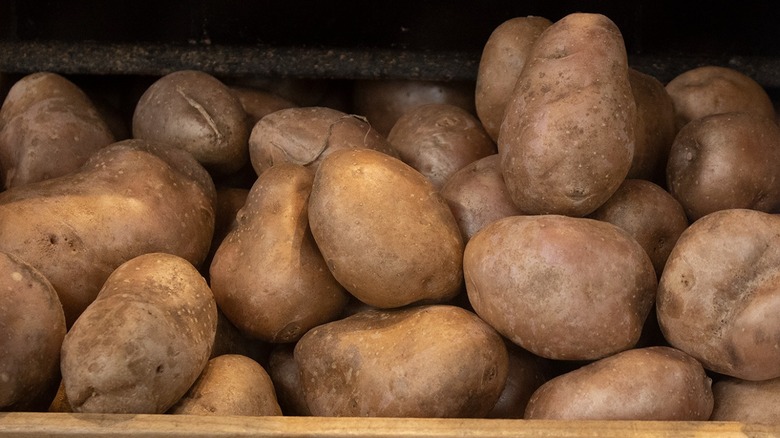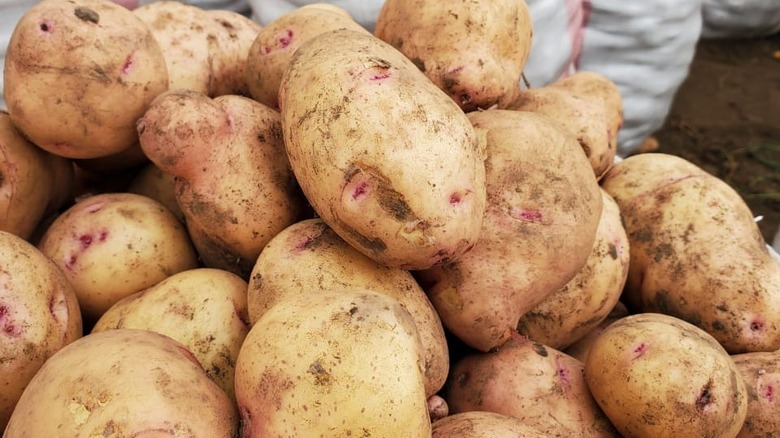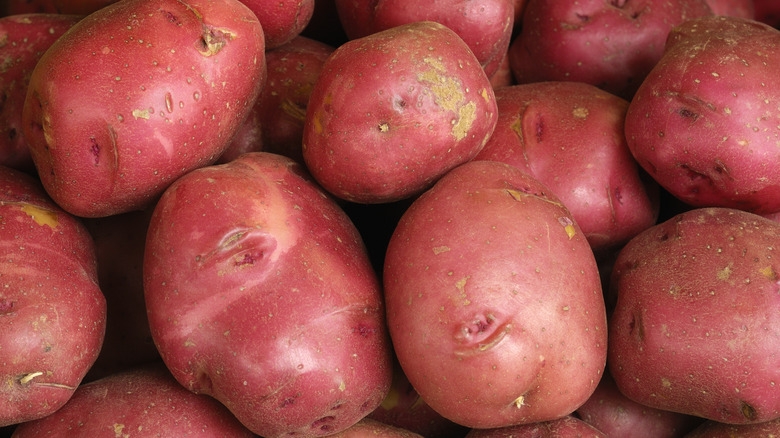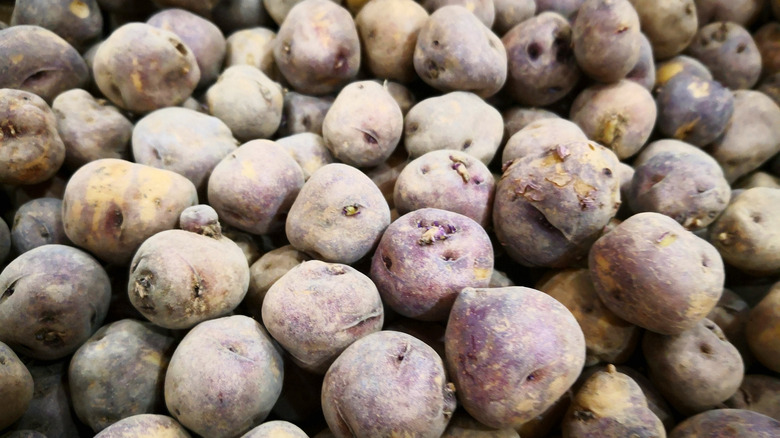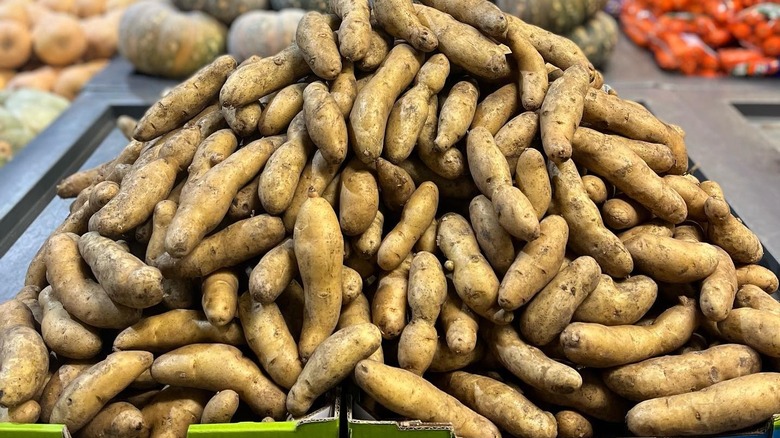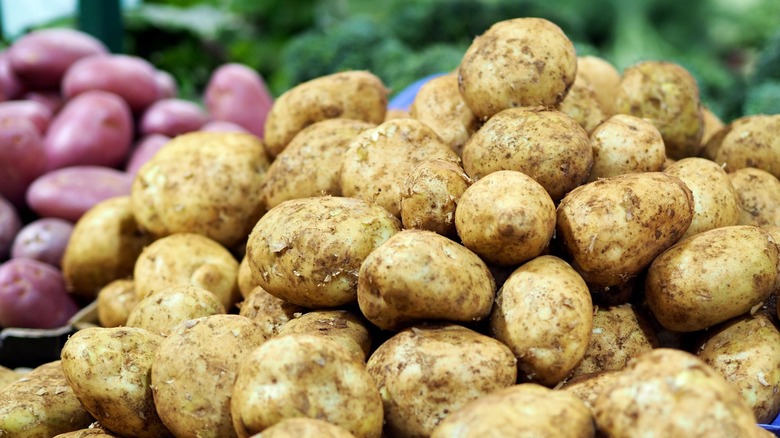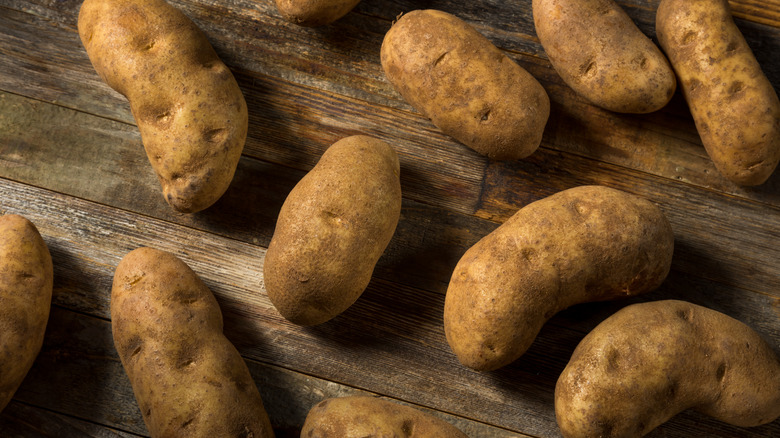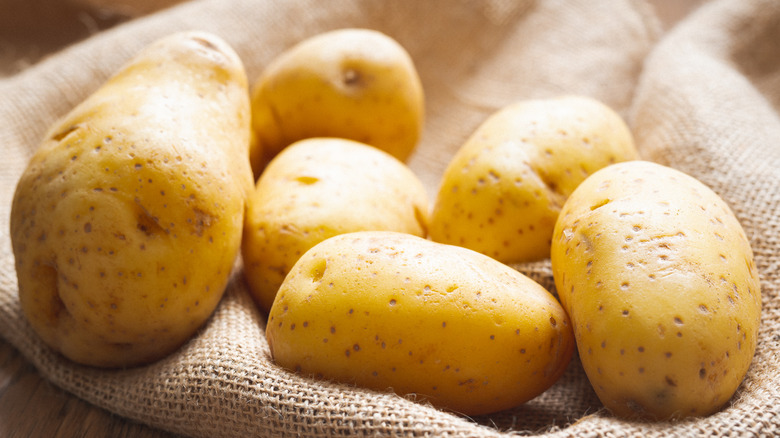14 Types Of Potatoes That Work Best For Roasting
The simple potato has a way of stealing any culinary show. But in the land of food, it's hard to argue against just how delicious potatoes can be. After all, just ask yourself if you'd rather have another helping of mashed potatoes or another helping of turkey during your next holiday meal. If you're like us, it's mashed potatoes all the way.
With how versatile potatoes are, there are a number of ways you can prepare them. Roasting them is a tried and true method of maintaining the delicious texture of the potato while adding a nice, crisp edge to it. However, while it's possible to mash just about any kind of potato out there, not all potatoes take to roasting. You need a potato that can hold up to extensive heat and not completely fall apart in the oven. The last thing you want is to open the oven door only to discover your roasted potato dish has turned to flaky mush. What are some potatoes that will not only give you a delicious meal but will stay intact while roasting under heavy heat in the oven? Here are some of the best potatoes you need to consider for roasting.
Maris Piper potatoes
If you're in the U.S., Maris Piper potatoes might not sound familiar. But if you're in the U.K., you're likely extremely familiar with them. This is a classic potato for making British chips. They're also a solid option for roasting. This is a "newer" potato in that it was first developed back in the 1960s in order to resist a common potato pest known as the "potato cyst nematode." This particular pest was common in the United Kingdom, and so farmers wanted to develop a potato crop that would not become easily infected.
These particular potatoes have a very low internal sugar level, which also means the Maris Piper does not have the same kind of elevated sweetness as some other strands of potatoes do on the market. Thanks to its robust nature, the potato can be grown year-round, and while it is most commonly used for producing french fries in the U.K., it can be used for other cooking purposes, as well. This includes roasting, although there will be a slight fluff to Maris Piper roasted potatoes.
King Edward potatoes
Speaking of British potatoes, probably the only potato more popular than the Maris Piper is the King Edward. Sure, it is a bit like reaching for an Abraham Lincoln spud, but still. These potatoes have a reddish-tan color and are great for the chip side of fish and chips.
The majority of potatoes in use today have been around for hundreds of years and are the result of natural evolution based on the localized climate. However, the King Edward potato was first created back around the turn of the 20th century. The potato actually went by a few different names prior to 1902. Originally, it was known as the Fellside Hero potato. Eventually, the strand of potato was passed between several farmers in England. To help boost the potato's popularity, it was renamed the King England potato in 1902, which was done to help commemorate the then-recent coronation of King Edward VII.
Beyond the rather interesting history of the potato, this is an excellent frying and roasting potato. Much like the Maris Piper potato, these will be on the fluffier side of the roasting spectrum, due to the higher starch levels.
Dutch cream potatoes
While cream might be in the name, Dutch cream potatoes are some of the best potatoes you can use when it comes to roasting. Why? They have a nice waxy skin, and the flesh has a natural buttery flavor to it. The potatoes have less starch, so they won't fall apart during your potato roasting, which is another major benefit.
Dutch cream potatoes are very much an all-things potato. You can turn them into mashed potatoes, fry them, bake them, and, of course, you can roast them. Sometimes, if you are at a grocery store with a large number of potatoes for sale, it can prove a challenge to remember which potatoes are good for roasting and which will simply fall apart on you. We feel you. Your best option, if you can't remember any names (although we think "Dutch cream" is an easier name to remember as it is so unique), is to look at the skin. If it has waxy, semi-glossy skin, it is going to be better for roasting. If the potato is dull and lifeless with no sheen, you'll want to use those for mashing.
Canchan potatoes
You better believe when there are over 4,000 varieties of potatoes from Peru, according to the International Potato Center, that you're going to see a number of spuds coming from the South American nation. If you're shopping around in Peru, you're probably going to find these listed as papa (potato) Canchan, but if you are lucky enough to be in a grocery store elsewhere that imports these, they may be called Papa Rosada, or pink potato (depending on if the grocery store wants to use the Spanish translation or not).
The Canchan potato is a waxy, red-skinned potato. It is especially firm and dense, which makes it a fantastic option for roasting. Potatoes are very important to the cuisine of Peru. These potatoes in particular are used heavily around the city of Cusco (which you might know better as the gateway city to Machu Picchu). However, despite the potato's popularity, you might not realize it is also a newer strand of potato, as it first exploded onto the scene back around 1990. But it won't explode when being roasted, as it's an ideal potato for roasting.
Kestrel potatoes
This is another potato strand that is considered "new." It was developed by a plant breeder back in 1992 and possesses a subtle, sweet taste. So if you want to add a hint of natural sweetness to your meal, consider the Kestrel potato. Unlike other potato strands and variations out there though, the Kestrel potato actually has its own branding and marketing behind it. It's like if the "Got Milk" people decided to throw their weight behind a singular kind of potato.
The Kestrel potato hails from Australia and, chances are, unless you are in the land Down Under, or have stumbled upon a rather impressive vegetable import store, you probably won't happen onto these potatoes. This is because the Kestrel potato is exclusively grown by the SA Potato Company. Just know that if you ever move to Australia, or are visiting during the holidays and you really want to make a good ol' U.S.A.-style Thanksgiving Dinner, you can reach for Kestrel potatoes and they will work just fine for all your roasting needs.
Huayro Macho potatoes
The Huayro Macho potatoes are some of the most beautiful potatoes you will find. There is a slightly waxy red skin to this potato, and the interior is made up of white flesh with a reddish-purple pigment on the interior. Want to impress your guests? Have this beautiful potato cut open and roasted with your meal.
This is another Peruvian potato that is cultivated and ready for consumption during the summer and fall times of Peru, which translates to the winter and spring in the United States. Unlike other potatoes, that are quick to grow and sprout, this potato variation does take longer to develop underground, which is why the potato is not available year-round. While the previous Papa Rosada potato is a newer strand, this potato has been around since the Incas. If you're going to roast up some potatoes, you might as well do so with a kind that has an impressive historical pedigree behind it, right? At the very least, it makes for an excellent conversation piece.
Désirée potatoes
Sure, it's a potato with a pretty fancy name, but that doesn't mean it can't stand up to the heat. Désirée potatoes are from Holland, and they have reddish skin and a golden interior. So not only is this potato variety great for roasting, but it's going to bring with it a burst of color and flavor.
The potato has been grown since the early 1960s. While it is possible for the potato to grow to rather large sizes, the Désirée potato is often harvested a few weeks early. The potato is still on the larger side at this point, and by removing it from the soil a few weeks early, farmers are then able to plant another crop faster. While the potato is predominantly grown in Holland, England, and surrounding areas, it is possible to find the Désirée potato in other parts of the world. Of course, as it is somewhat similar to the standard red potato found in the United States, it often is not imported. However, because the potato is versatile, it is possible to purchase potato seeds and grow them yourself, should you find you enjoy the taste and texture of Désirée potatoes better than your average red potato here in the States.
Unica potatoes
This is an adaptable potato. It comes from Peru, but it is now cultivated in various regions around the world, including Kenya. The Unica potato has strong defenses against rotting, which is one reason it is such a desirable plant, and it also holds up well when roasting.
The Unica potato is one of the newer Peruvian potatoes, as it was first produced back in 1998. However, because it is such a versatile potato in terms of its growing environment, it has since been exported out to regions all around the globe where most potatoes are unable to grow due to various reasons (such as heat or lack of moisture). In fact, the International Potato Center (yes, this really is a thing) works with potato farmers around the world in order to help cultivate and even produce specialized potatoes that can handle various growing conditions. The Unica potato just happens to be a particular style of potato that holds up exceptionally well when roasting.
Red potatoes
We do love some creamy garlic mashed red potatoes. The potato skin looks beautiful, especially if you leave them on while making mashed potatoes. In terms of roasting, though, the smooth, waxy skin makes them perfect. The only downside with these potatoes is they tend to have a higher moisture level, which means it can take longer for the red potatoes to roast all the way through.
Red potatoes are some of the most popular potatoes in the United States. In general, it's pretty easy to find red potatoes in just about any grocery store you pop into. However, these potatoes, like so many others, originated in Peru. After the Spanish discovered the potatoes during their search for gold in South America, they eventually took them back to Europe. The potatoes grew in popularity in Europe and then accompanied Europeans as they made their way to what would become the United States. So, yes, red potatoes took the very long route of bouncing from Peru to Spain to England to North America. But it was worth the journey, as they are excellent for roasting.
Negra potatoes
These Peruvian potatoes have a brighter, yellowish-white interior. When looking at the potatoes, they will likely have a darker purple color to them, although, despite this, the potatoes are referred to as Papa Negras or black potatoes. They are especially versatile and can be used in just about any dish you might be making, including a roasted dish.
The potatoes are common in many Peruvian dishes as they are hearty and will not fall apart easily. This is a major reason why negra potatoes, which also go by the names of Papa Mariva and Papa Tomasa, are a perfect addition to soups. The potatoes can take on a good amount of liquid without just turning to mush and falling apart. There is a subtle sweetness to these potatoes over other, starchier varieties. So if you have the chance to roast with these beautifully colorful potatoes, by all means, give them a try. Your dinner guests will love them.
Kipfler potatoes
The Kipfler potato first came from Austria. They have a unique shape to them in that they are stretched out, almost like a cucumber (but gold). This makes them super easy for slicing into discs for roasting. Because of the long, slender shape of the potato, they are also referred to as German finger potatoes. If you are the kind of person that absolutely hates slicing and dicing potatoes until they are in a perfect size, a handful of Kipfler potatoes will be perfect for you. Thanks to the long, slender nature of these potatoes, you can either just slice up circular discs of potatoes (which gives you that nice, golden skin around the entire potato when roasting it up), or, with a few basic cuts, you can have quartered potatoes the same size as the squash or carrots roasting right along with the Kipfler potatoes.
Best of all, these potatoes are available all year, so you won't have to wait until a certain time of year in order to track them down. You just need to figure out which local grocery store has them for sale.
Sebago potatoes
The Sebago potato is a popular potato in Australia, although it actually comes from Maine as a cross between two other potatoes. The versatile potato, which is about the size of a standard red potato but looks closer to a Yukon Gold potato, is great for roasting. So, if you're visiting Australia, you can still make your favorite potato dishes.
The Sebago potato is basically the all-purpose potato you want to have on hand, regardless of the recipe you might be making. It is often a good idea to just have a versatile potato at home, so instead of needing to go to the store to pick up something that works for mashing or roasting, you already have spuds in your back pocket (or, uh, pantry). Because there are already hearty, do-everything golden-like potatoes in the United States, the Sebago strand of potato is mostly available in Australia. However, you may be able to find it in select grocery stores in the United States.
Russet potatoes
These aren't the best of the best but still a fine option if you're in a pinch. Russet potatoes are a bit higher in starch, which means they are more likely to flake during the roasting process. This will though mean the potatoes will begin to puff up. Depending on what else you are roasting the potatoes with, this might be a suitable textural feature.
The Russet potato is the classic Irish potato that has been around for well over a hundred years now. Back during the Irish potato famine that raged through the country in the 19th century, farmers and researchers were trying to develop potatoes that were more resistant to the potato blight ripping through crops. Eventually, a botanist in the United States by the name of Luther Burbank developed a potato known as the Russet Burbank potato (after himself, naturally). He used the word "russet" which was in reference to the russeted or scuffed-up skin of the potato. Eventually, several dozen variations of the potato were created. To keep things simple though, the secondary name of the potatoes is usually dropped in grocery stores, and, instead, the spuds are simply known as Russet potatoes.
Yukon Gold potatoes
If we called these the gold standard of potatoes, how hard would you groan? It's okay. We like to think of it as making room in your stomach for the next batch of freshly roasted Yukon Gold Potatoes.
When looking for the best potatoes for roasting, you want a thin skin (so the interior has an easier time cooking), as well as a less-starchy potato, as starchy potatoes tend to flake apart when in the oven. Yukon Gold Potatoes are the best for all of this.
We have to admit, we really wish the Yukon Gold potatoes were somehow connected to the Gold Rush. Doesn't the name suggest it? The potato itself sounds like something Humphrey Bogart would have been searching for back in the 1940s. Disappointingly, the history behind these potatoes is nowhere as cool as that. Basically, the potatoes were developed over the course of 30 years in the Yukon territory of Canada. Eventually, the potatoes were released to the public in the 1960s. However, what isn't disappointing is just how well the Yukon Gold potatoes roast in the oven.
